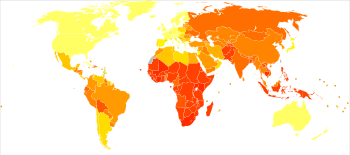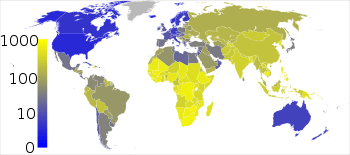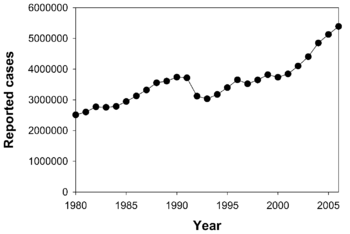Epidemiology of tuberculosis

no data
≤ 10
10–25
25–50
50–75
75–100
100–250
|
250–500
500–750
750–1000
1000–2000
2000–3000
≥ 3000
|

Roughly one-third of the world's population has been infected with M. tuberculosis, and new infections occur at a rate of one per second.[4] However, not all infections with M. tuberculosis cause tuberculosis disease and many infections are asymptomatic.[5] In 2007 there were an estimated 13.7 million chronic active cases,[6] and in 2010 there were 8.8 million new cases, and 1.45 million deaths, mostly in developing countries.[7] 0.35 million of these deaths occur in those co-infected with HIV.[8]
Tuberculosis is the second most common cause of death from infectious disease (after HIV).[9] The absolute number of tuberculosis cases has been decreasing since 2005 and new cases since 2002.[7] China has achieved particularly dramatic progress, with an 80 percent decline in its TB mortality rate.[10] The distribution of tuberculosis is not uniform across the globe; about 80% of the population in many Asian and African countries test positive in tuberculin tests, while only 5–10% of the U.S. population test positive.[11]
In 2007, the country with the highest estimated incidence rate of TB was Swaziland, with 1200 cases per 100,000 people. As of 2014, India has the largest total incidence, with an estimated 2.2 million new cases. India has more than 0.3 million deaths, and economic losses of $23 billion (Rs. 143123 crore) every year.[12][6] In developed countries, tuberculosis is less common and is mainly an urban disease. In the United Kingdom, the national average was 15 per 100,000 in 2007, and the highest incidence rates in Western Europe were 30 per 100,000 in Portugal and Spain. These rates compared with 98 per 100,000 in China and 48 per 100,000 in Brazil. In the United States, the overall tuberculosis case rate was 4 per 100,000 persons in 2007.[2] In Canada, tuberculosis is still endemic in some rural areas.[13]
The incidence of TB varies with age. In Africa, TB primarily affects adolescents and young adults.[14] However, in countries where TB has gone from high to low incidence, such as the United States, TB is mainly a disease of older people, or of the immunocompromised.[11][15]
Tuberculosis incidence is seasonal, with peaks occurring every spring/summer.[16][17][18][19] The reasons for this are unclear, but may be related to vitamin D deficiency during the winter.[19][20]
In Europe, deaths from TB fell from 500 out of 100,000 in 1850 to 50 out of 100,000 by 1950. Improvements in public health were reducing tuberculosis even before the arrival of antibiotics, although the disease remained a significant threat to public health, such that when the Medical Research Council was formed in Britain in 1913 its initial focus was tuberculosis research.[21]
References
- ↑ "WHO Disease and injury country estimates". World Health Organization. 2004. Retrieved 11 November 2009.
- ↑ 2.0 2.1 World Health Organization (2009). "The Stop TB Strategy, case reports, treatment outcomes and estimates of TB burden". Global tuberculosis control: epidemiology, strategy, financing. pp. 187–300. ISBN 9789241563802. Retrieved 14 November 2009.
- ↑ World Health Organization. "WHO report 2008: Global tuberculosis control". Retrieved 13 April 2009.
- ↑ "Tuberculosis Fact sheet N°104". World Health Organization. November 2010. Retrieved 26 July 2011.
- ↑ "Fact Sheets: The Difference Between Latent TB Infection and Active TB Disease". Centers for Disease Control. 20 June 2011. Retrieved 26 July 2011.
- ↑ 6.0 6.1 World Health Organization (2009). "Epidemiology". Global tuberculosis control: epidemiology, strategy, financing. pp. 6–33. ISBN 9789241563802. Retrieved 12 November 2009.
- ↑ 7.0 7.1 "The sixteenth global report on tuberculosis". 2011.
- ↑ http://www.who.int/tb/publications/global_report/2011/gtbr11_full.pdf
- ↑ Dolin, [edited by] Gerald L. Mandell, John E. Bennett, Raphael (2010). Mandell, Douglas, and Bennett's principles and practice of infectious diseases (7th ed.). Philadelphia, PA: Churchill Livingstone/Elsevier. pp. Chapter 250. ISBN 978-0443068393.
- ↑ Global Tuberculosis Control, World Health Organization, 2011
- ↑ 11.0 11.1 Kumar V, Abbas AK, Fausto N, Mitchell RN (2007). Robbins Basic Pathology (8th ed.). Saunders Elsevier. pp. 516–522. ISBN 978-1-4160-2973-1.
- ↑ IANS (24 March 2015). "World Tuberculosis Day: India Needs Political Will To Eradicate TB Shows Study". The Huffington Post. Retrieved 24 March 2015.
- ↑ Al-Azem A, Kaushal Sharma M, Turenne C, Hoban D, Hershfield E, MacMorran J, Kabani A (1998). "Rural outbreaks of Mycobacterium tuberculosis in a Canadian province". Abstr Intersci Conf Antimicrob Agents Chemother Intersci Conf Antimicrob Agents Chemother 38: 555. abstract no. L-27.
- ↑ World Health Organization. "Global Tuberculosis Control Report, 2006 – Annex 1 Profiles of high-burden countries" (PDF). Retrieved 13 October 2006.
- ↑ Centers for Disease Control and Prevention (12 September 2006). "2005 Surveillance Slide Set". Retrieved 13 October 2006.
- ↑ Douglas AS, Strachan DP, Maxwell JD (1996). "Seasonality of tuberculosis: the reverse of other respiratory diseases in the UK". Thorax 51: 944–946. doi:10.1136/thx.51.9.944.
- ↑ Martineau AR, Nhamoyebonde S, Oni T, Rangaka MX, Marais S et al. (2011). "Reciprocal seasonal variation in vitamin D status and tuberculosis notifications in Cape Town, South Africa.". Proc Natl Acad Sci U S A 108: 19013–19017. doi:10.1073/pnas.1111825108.
- ↑ Parrinello CM, Crossa A, Harris TG (2012). "Seasonality of tuberculosis in New York City, 1990–2007.". Int J Tuberc Lung Dis 16: 32–37. doi:10.5588/ijtld.11.0145.
- ↑ 19.0 19.1 Korthals Altes H, Kremer K, Erkens C, Van Soolingen D, Wallinga J (2012). "Tuberculosis seasonality in the Netherlands differs between natives and non-natives: a role for vitamin D deficiency?". Int J Tuberc Lung Dis 16: 639–644. doi:10.5588/ijtld.11.0680.
- ↑ Koh GCKW, Hawthorne G, Turner AM, Kunst H, Dedicoat M (2013). "Tuberculosis incidence correlates with sunshine: an ecological 28-year time series study". PLoS ONE. doi:10.1371/journal.pone.0057752.
- ↑ Medical Research Council.Origins of the MRC. Accessed 7 October 2006.
